MG414 Organisational Behaviour: Hilton Hotel's Culture and Motivation
VerifiedAdded on 2022/11/30
|11
|3511
|163
Report
AI Summary
This report provides a detailed analysis of Hilton Hotels' organisational behaviour, focusing on various aspects such as its culture, employee motivation, and strategies for enhancing success. The report begins by identifying Hilton's culture in line with theoretical models, exploring how culture improves organisational effectiveness with a focus on communication. It then evaluates the role of culture on employee motivation, referencing Maslow's Hierarchy of Needs, and suggests ways the company can leverage its culture to further enhance its success. The report covers topics like organizational culture, communication, employee motivation, and the application of organizational theories to a real-world business case. The report also explores the impact of organizational culture on employee well-being and performance, and the role of transparency in fostering employee engagement and overall organizational success. The report concludes with a summary of findings and recommendations for Hilton Hotel.
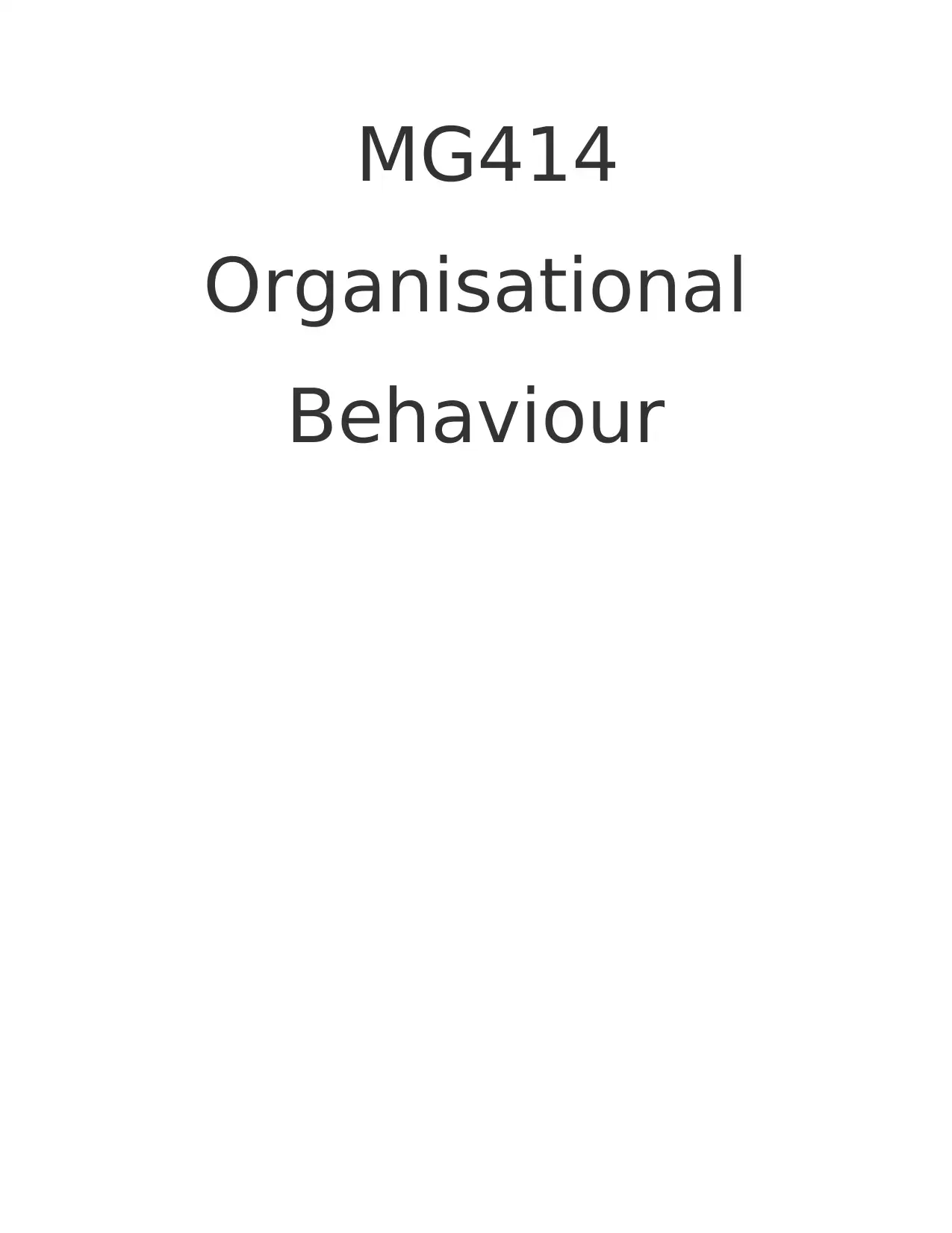
MG414
Organisational
Behaviour
Organisational
Behaviour
Paraphrase This Document
Need a fresh take? Get an instant paraphrase of this document with our AI Paraphraser
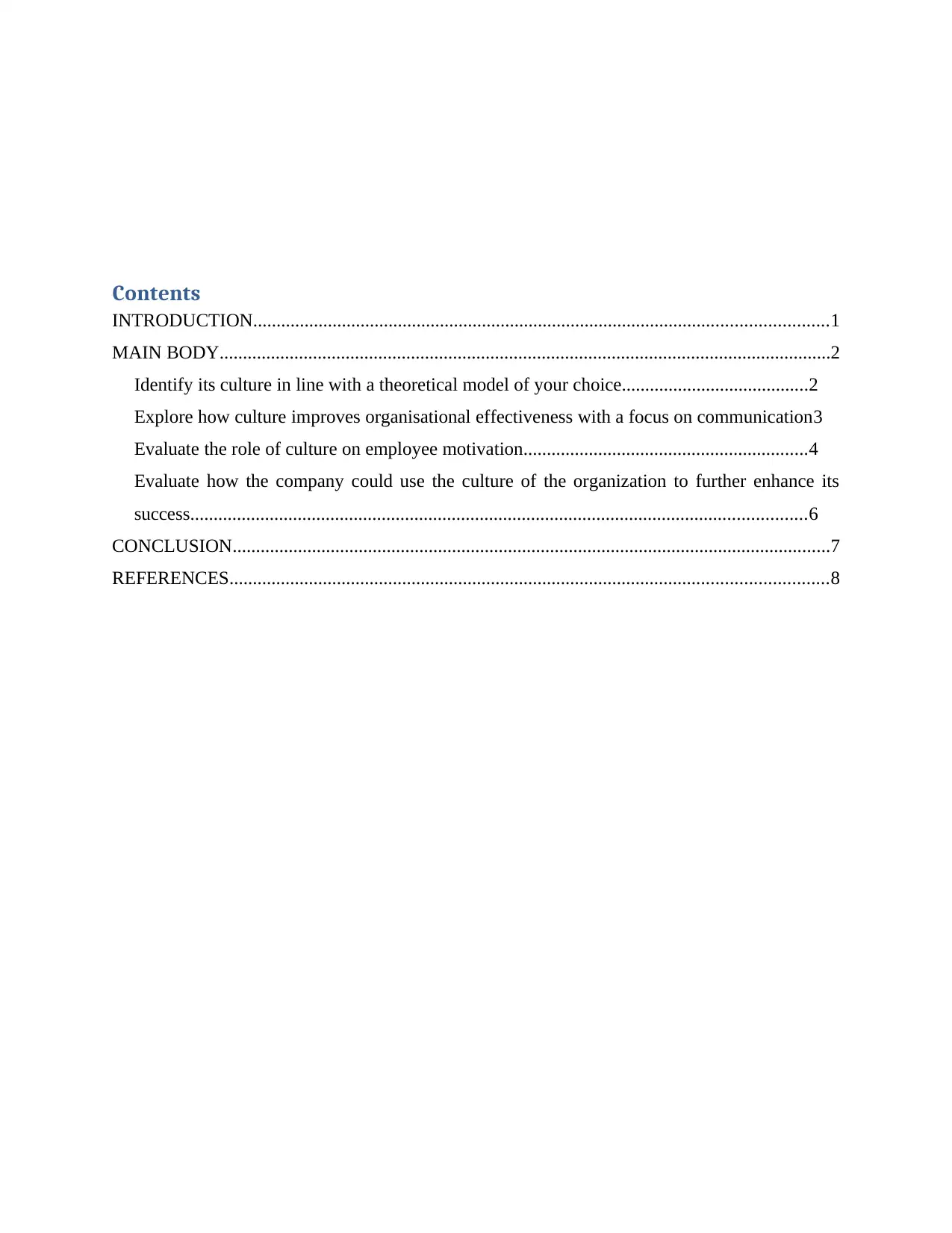
Contents
INTRODUCTION...........................................................................................................................1
MAIN BODY...................................................................................................................................2
Identify its culture in line with a theoretical model of your choice........................................2
Explore how culture improves organisational effectiveness with a focus on communication3
Evaluate the role of culture on employee motivation.............................................................4
Evaluate how the company could use the culture of the organization to further enhance its
success....................................................................................................................................6
CONCLUSION................................................................................................................................7
REFERENCES................................................................................................................................8
INTRODUCTION...........................................................................................................................1
MAIN BODY...................................................................................................................................2
Identify its culture in line with a theoretical model of your choice........................................2
Explore how culture improves organisational effectiveness with a focus on communication3
Evaluate the role of culture on employee motivation.............................................................4
Evaluate how the company could use the culture of the organization to further enhance its
success....................................................................................................................................6
CONCLUSION................................................................................................................................7
REFERENCES................................................................................................................................8
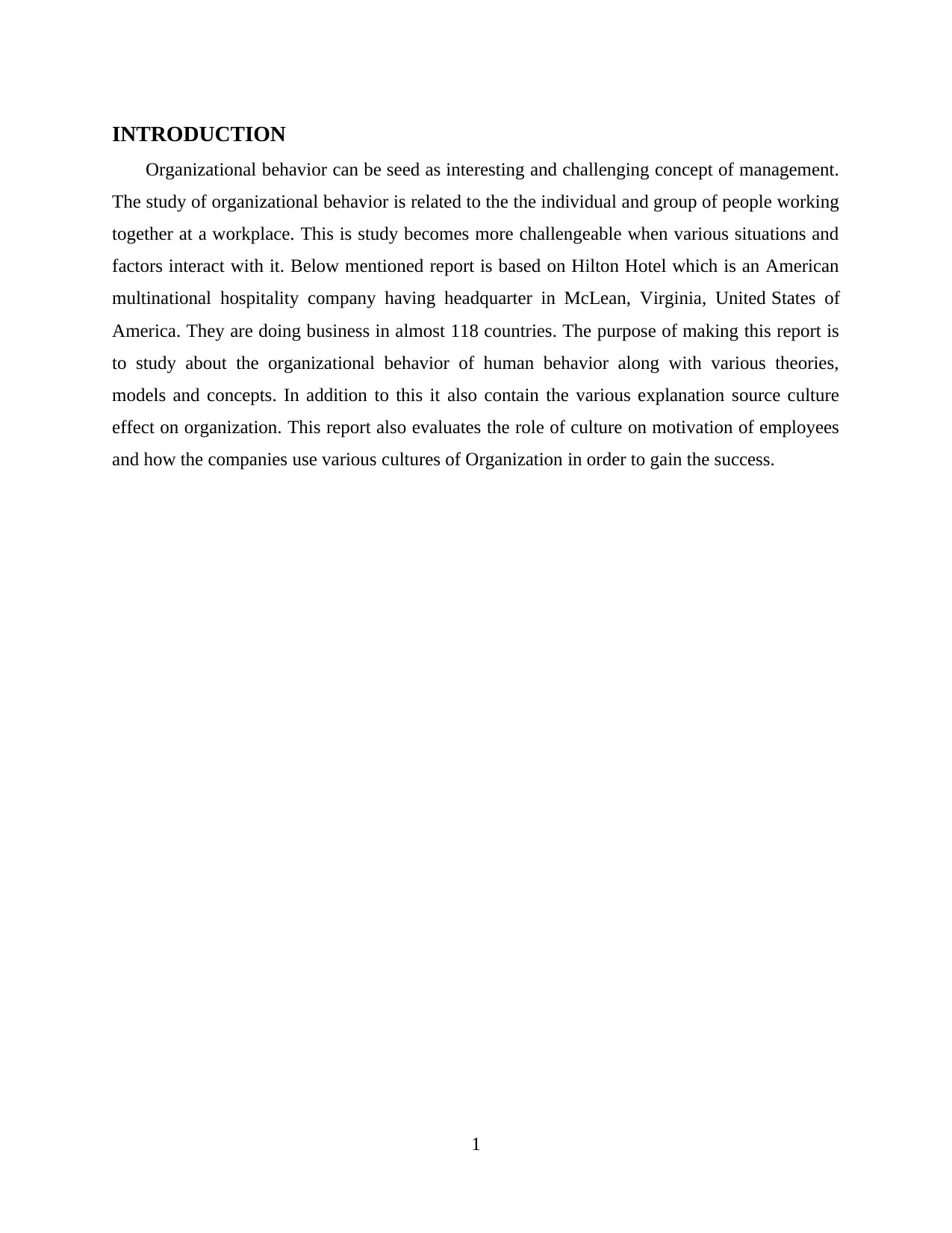
INTRODUCTION
Organizational behavior can be seed as interesting and challenging concept of management.
The study of organizational behavior is related to the the individual and group of people working
together at a workplace. This is study becomes more challengeable when various situations and
factors interact with it. Below mentioned report is based on Hilton Hotel which is an American
multinational hospitality company having headquarter in McLean, Virginia, United States of
America. They are doing business in almost 118 countries. The purpose of making this report is
to study about the organizational behavior of human behavior along with various theories,
models and concepts. In addition to this it also contain the various explanation source culture
effect on organization. This report also evaluates the role of culture on motivation of employees
and how the companies use various cultures of Organization in order to gain the success.
1
Organizational behavior can be seed as interesting and challenging concept of management.
The study of organizational behavior is related to the the individual and group of people working
together at a workplace. This is study becomes more challengeable when various situations and
factors interact with it. Below mentioned report is based on Hilton Hotel which is an American
multinational hospitality company having headquarter in McLean, Virginia, United States of
America. They are doing business in almost 118 countries. The purpose of making this report is
to study about the organizational behavior of human behavior along with various theories,
models and concepts. In addition to this it also contain the various explanation source culture
effect on organization. This report also evaluates the role of culture on motivation of employees
and how the companies use various cultures of Organization in order to gain the success.
1
⊘ This is a preview!⊘
Do you want full access?
Subscribe today to unlock all pages.

Trusted by 1+ million students worldwide
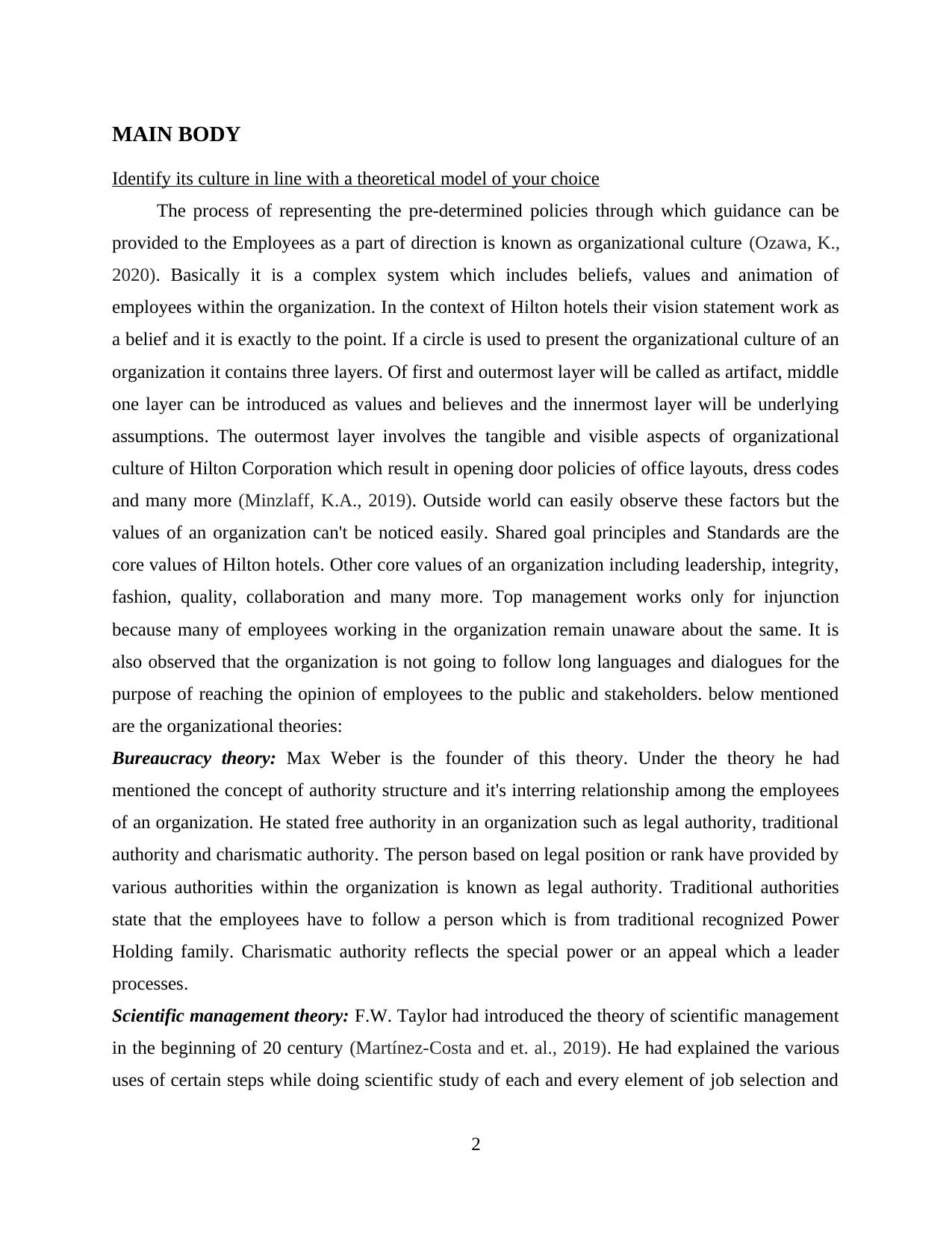
MAIN BODY
Identify its culture in line with a theoretical model of your choice
The process of representing the pre-determined policies through which guidance can be
provided to the Employees as a part of direction is known as organizational culture (Ozawa, K.,
2020). Basically it is a complex system which includes beliefs, values and animation of
employees within the organization. In the context of Hilton hotels their vision statement work as
a belief and it is exactly to the point. If a circle is used to present the organizational culture of an
organization it contains three layers. Of first and outermost layer will be called as artifact, middle
one layer can be introduced as values and believes and the innermost layer will be underlying
assumptions. The outermost layer involves the tangible and visible aspects of organizational
culture of Hilton Corporation which result in opening door policies of office layouts, dress codes
and many more (Minzlaff, K.A., 2019). Outside world can easily observe these factors but the
values of an organization can't be noticed easily. Shared goal principles and Standards are the
core values of Hilton hotels. Other core values of an organization including leadership, integrity,
fashion, quality, collaboration and many more. Top management works only for injunction
because many of employees working in the organization remain unaware about the same. It is
also observed that the organization is not going to follow long languages and dialogues for the
purpose of reaching the opinion of employees to the public and stakeholders. below mentioned
are the organizational theories:
Bureaucracy theory: Max Weber is the founder of this theory. Under the theory he had
mentioned the concept of authority structure and it's interring relationship among the employees
of an organization. He stated free authority in an organization such as legal authority, traditional
authority and charismatic authority. The person based on legal position or rank have provided by
various authorities within the organization is known as legal authority. Traditional authorities
state that the employees have to follow a person which is from traditional recognized Power
Holding family. Charismatic authority reflects the special power or an appeal which a leader
processes.
Scientific management theory: F.W. Taylor had introduced the theory of scientific management
in the beginning of 20 century (Martínez-Costa and et. al., 2019). He had explained the various
uses of certain steps while doing scientific study of each and every element of job selection and
2
Identify its culture in line with a theoretical model of your choice
The process of representing the pre-determined policies through which guidance can be
provided to the Employees as a part of direction is known as organizational culture (Ozawa, K.,
2020). Basically it is a complex system which includes beliefs, values and animation of
employees within the organization. In the context of Hilton hotels their vision statement work as
a belief and it is exactly to the point. If a circle is used to present the organizational culture of an
organization it contains three layers. Of first and outermost layer will be called as artifact, middle
one layer can be introduced as values and believes and the innermost layer will be underlying
assumptions. The outermost layer involves the tangible and visible aspects of organizational
culture of Hilton Corporation which result in opening door policies of office layouts, dress codes
and many more (Minzlaff, K.A., 2019). Outside world can easily observe these factors but the
values of an organization can't be noticed easily. Shared goal principles and Standards are the
core values of Hilton hotels. Other core values of an organization including leadership, integrity,
fashion, quality, collaboration and many more. Top management works only for injunction
because many of employees working in the organization remain unaware about the same. It is
also observed that the organization is not going to follow long languages and dialogues for the
purpose of reaching the opinion of employees to the public and stakeholders. below mentioned
are the organizational theories:
Bureaucracy theory: Max Weber is the founder of this theory. Under the theory he had
mentioned the concept of authority structure and it's interring relationship among the employees
of an organization. He stated free authority in an organization such as legal authority, traditional
authority and charismatic authority. The person based on legal position or rank have provided by
various authorities within the organization is known as legal authority. Traditional authorities
state that the employees have to follow a person which is from traditional recognized Power
Holding family. Charismatic authority reflects the special power or an appeal which a leader
processes.
Scientific management theory: F.W. Taylor had introduced the theory of scientific management
in the beginning of 20 century (Martínez-Costa and et. al., 2019). He had explained the various
uses of certain steps while doing scientific study of each and every element of job selection and
2
Paraphrase This Document
Need a fresh take? Get an instant paraphrase of this document with our AI Paraphraser
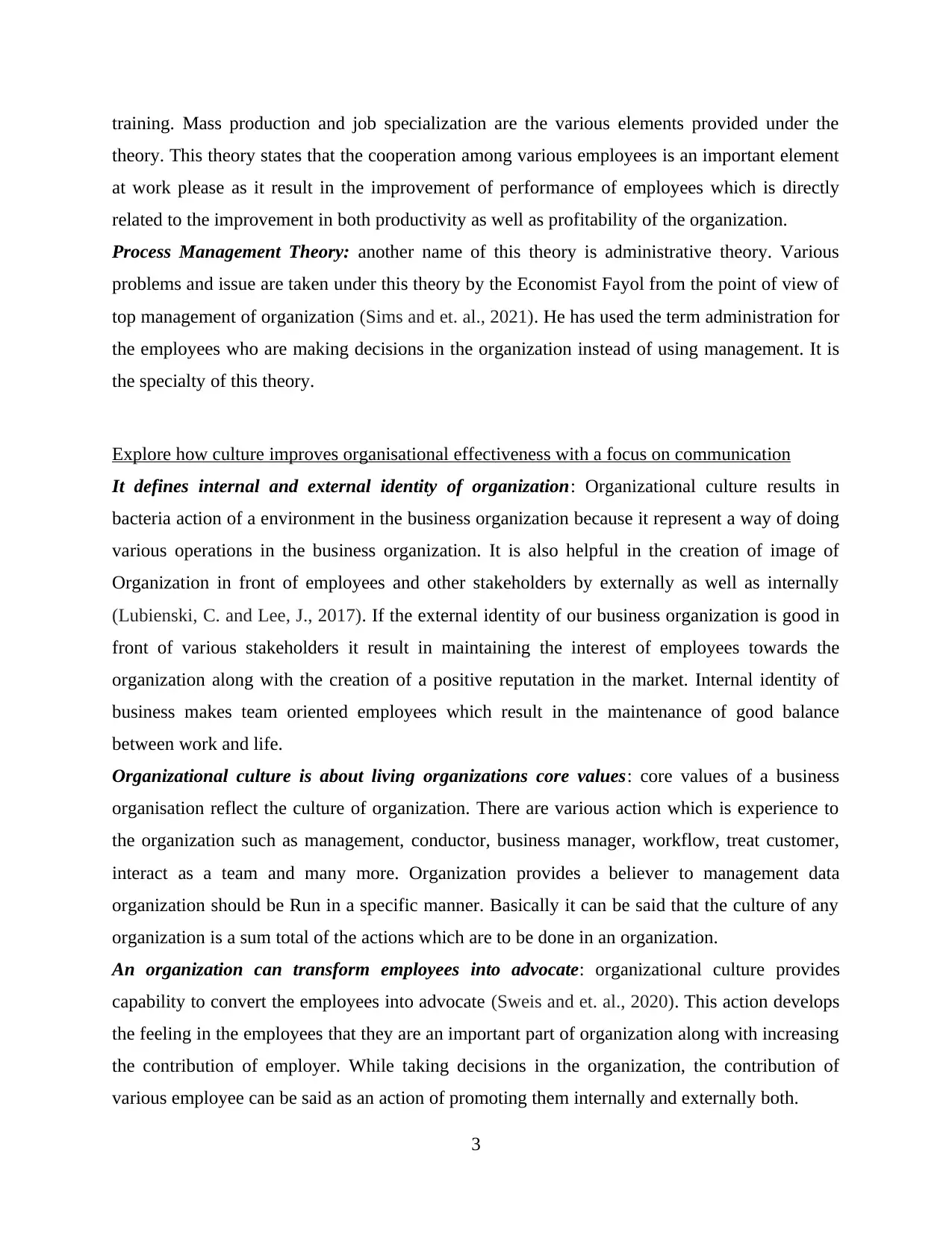
training. Mass production and job specialization are the various elements provided under the
theory. This theory states that the cooperation among various employees is an important element
at work please as it result in the improvement of performance of employees which is directly
related to the improvement in both productivity as well as profitability of the organization.
Process Management Theory: another name of this theory is administrative theory. Various
problems and issue are taken under this theory by the Economist Fayol from the point of view of
top management of organization (Sims and et. al., 2021). He has used the term administration for
the employees who are making decisions in the organization instead of using management. It is
the specialty of this theory.
Explore how culture improves organisational effectiveness with a focus on communication
It defines internal and external identity of organization: Organizational culture results in
bacteria action of a environment in the business organization because it represent a way of doing
various operations in the business organization. It is also helpful in the creation of image of
Organization in front of employees and other stakeholders by externally as well as internally
(Lubienski, C. and Lee, J., 2017). If the external identity of our business organization is good in
front of various stakeholders it result in maintaining the interest of employees towards the
organization along with the creation of a positive reputation in the market. Internal identity of
business makes team oriented employees which result in the maintenance of good balance
between work and life.
Organizational culture is about living organizations core values: core values of a business
organisation reflect the culture of organization. There are various action which is experience to
the organization such as management, conductor, business manager, workflow, treat customer,
interact as a team and many more. Organization provides a believer to management data
organization should be Run in a specific manner. Basically it can be said that the culture of any
organization is a sum total of the actions which are to be done in an organization.
An organization can transform employees into advocate: organizational culture provides
capability to convert the employees into advocate (Sweis and et. al., 2020). This action develops
the feeling in the employees that they are an important part of organization along with increasing
the contribution of employer. While taking decisions in the organization, the contribution of
various employee can be said as an action of promoting them internally and externally both.
3
theory. This theory states that the cooperation among various employees is an important element
at work please as it result in the improvement of performance of employees which is directly
related to the improvement in both productivity as well as profitability of the organization.
Process Management Theory: another name of this theory is administrative theory. Various
problems and issue are taken under this theory by the Economist Fayol from the point of view of
top management of organization (Sims and et. al., 2021). He has used the term administration for
the employees who are making decisions in the organization instead of using management. It is
the specialty of this theory.
Explore how culture improves organisational effectiveness with a focus on communication
It defines internal and external identity of organization: Organizational culture results in
bacteria action of a environment in the business organization because it represent a way of doing
various operations in the business organization. It is also helpful in the creation of image of
Organization in front of employees and other stakeholders by externally as well as internally
(Lubienski, C. and Lee, J., 2017). If the external identity of our business organization is good in
front of various stakeholders it result in maintaining the interest of employees towards the
organization along with the creation of a positive reputation in the market. Internal identity of
business makes team oriented employees which result in the maintenance of good balance
between work and life.
Organizational culture is about living organizations core values: core values of a business
organisation reflect the culture of organization. There are various action which is experience to
the organization such as management, conductor, business manager, workflow, treat customer,
interact as a team and many more. Organization provides a believer to management data
organization should be Run in a specific manner. Basically it can be said that the culture of any
organization is a sum total of the actions which are to be done in an organization.
An organization can transform employees into advocate: organizational culture provides
capability to convert the employees into advocate (Sweis and et. al., 2020). This action develops
the feeling in the employees that they are an important part of organization along with increasing
the contribution of employer. While taking decisions in the organization, the contribution of
various employee can be said as an action of promoting them internally and externally both.
3
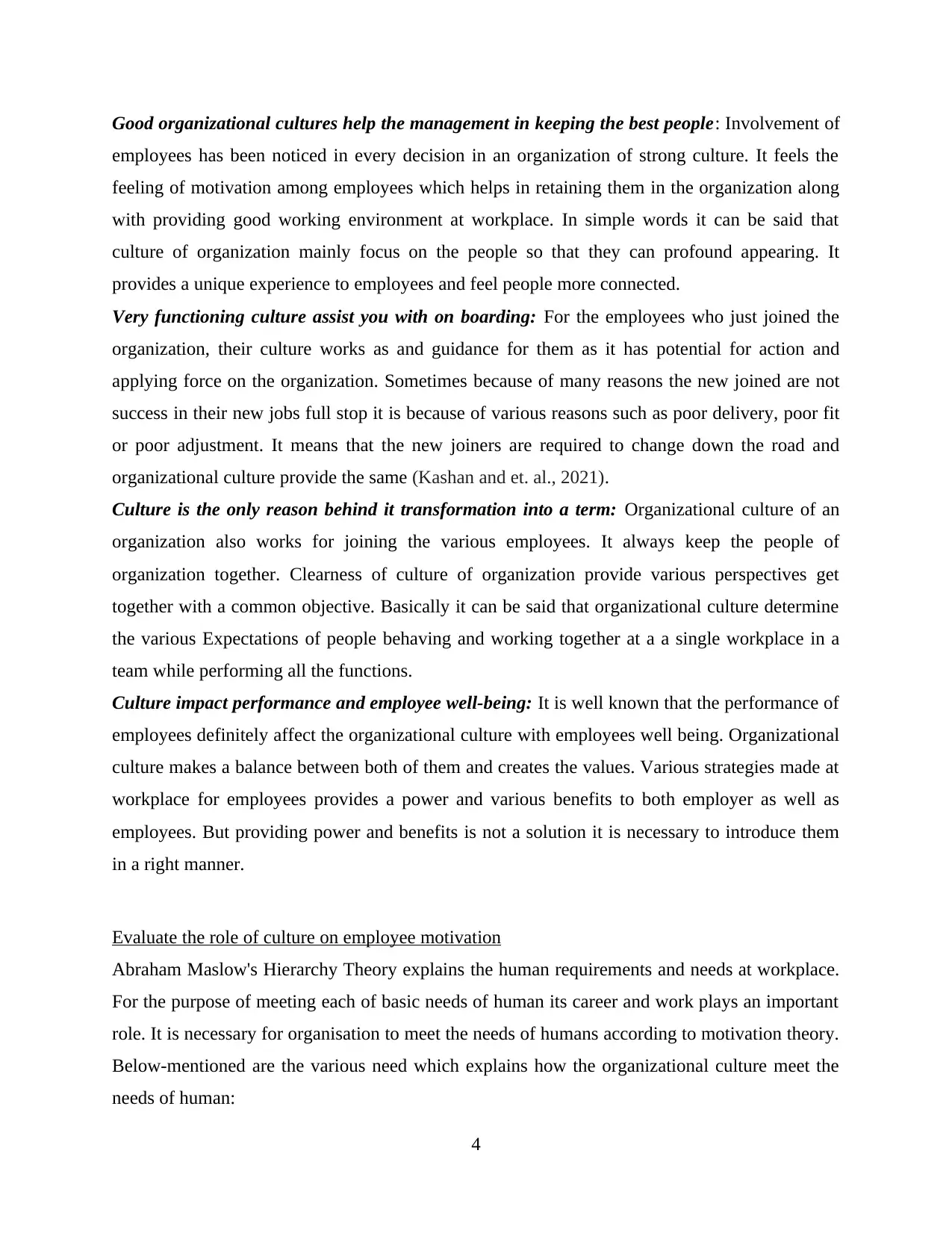
Good organizational cultures help the management in keeping the best people: Involvement of
employees has been noticed in every decision in an organization of strong culture. It feels the
feeling of motivation among employees which helps in retaining them in the organization along
with providing good working environment at workplace. In simple words it can be said that
culture of organization mainly focus on the people so that they can profound appearing. It
provides a unique experience to employees and feel people more connected.
Very functioning culture assist you with on boarding: For the employees who just joined the
organization, their culture works as and guidance for them as it has potential for action and
applying force on the organization. Sometimes because of many reasons the new joined are not
success in their new jobs full stop it is because of various reasons such as poor delivery, poor fit
or poor adjustment. It means that the new joiners are required to change down the road and
organizational culture provide the same (Kashan and et. al., 2021).
Culture is the only reason behind it transformation into a term: Organizational culture of an
organization also works for joining the various employees. It always keep the people of
organization together. Clearness of culture of organization provide various perspectives get
together with a common objective. Basically it can be said that organizational culture determine
the various Expectations of people behaving and working together at a a single workplace in a
team while performing all the functions.
Culture impact performance and employee well-being: It is well known that the performance of
employees definitely affect the organizational culture with employees well being. Organizational
culture makes a balance between both of them and creates the values. Various strategies made at
workplace for employees provides a power and various benefits to both employer as well as
employees. But providing power and benefits is not a solution it is necessary to introduce them
in a right manner.
Evaluate the role of culture on employee motivation
Abraham Maslow's Hierarchy Theory explains the human requirements and needs at workplace.
For the purpose of meeting each of basic needs of human its career and work plays an important
role. It is necessary for organisation to meet the needs of humans according to motivation theory.
Below-mentioned are the various need which explains how the organizational culture meet the
needs of human:
4
employees has been noticed in every decision in an organization of strong culture. It feels the
feeling of motivation among employees which helps in retaining them in the organization along
with providing good working environment at workplace. In simple words it can be said that
culture of organization mainly focus on the people so that they can profound appearing. It
provides a unique experience to employees and feel people more connected.
Very functioning culture assist you with on boarding: For the employees who just joined the
organization, their culture works as and guidance for them as it has potential for action and
applying force on the organization. Sometimes because of many reasons the new joined are not
success in their new jobs full stop it is because of various reasons such as poor delivery, poor fit
or poor adjustment. It means that the new joiners are required to change down the road and
organizational culture provide the same (Kashan and et. al., 2021).
Culture is the only reason behind it transformation into a term: Organizational culture of an
organization also works for joining the various employees. It always keep the people of
organization together. Clearness of culture of organization provide various perspectives get
together with a common objective. Basically it can be said that organizational culture determine
the various Expectations of people behaving and working together at a a single workplace in a
team while performing all the functions.
Culture impact performance and employee well-being: It is well known that the performance of
employees definitely affect the organizational culture with employees well being. Organizational
culture makes a balance between both of them and creates the values. Various strategies made at
workplace for employees provides a power and various benefits to both employer as well as
employees. But providing power and benefits is not a solution it is necessary to introduce them
in a right manner.
Evaluate the role of culture on employee motivation
Abraham Maslow's Hierarchy Theory explains the human requirements and needs at workplace.
For the purpose of meeting each of basic needs of human its career and work plays an important
role. It is necessary for organisation to meet the needs of humans according to motivation theory.
Below-mentioned are the various need which explains how the organizational culture meet the
needs of human:
4
⊘ This is a preview!⊘
Do you want full access?
Subscribe today to unlock all pages.

Trusted by 1+ million students worldwide
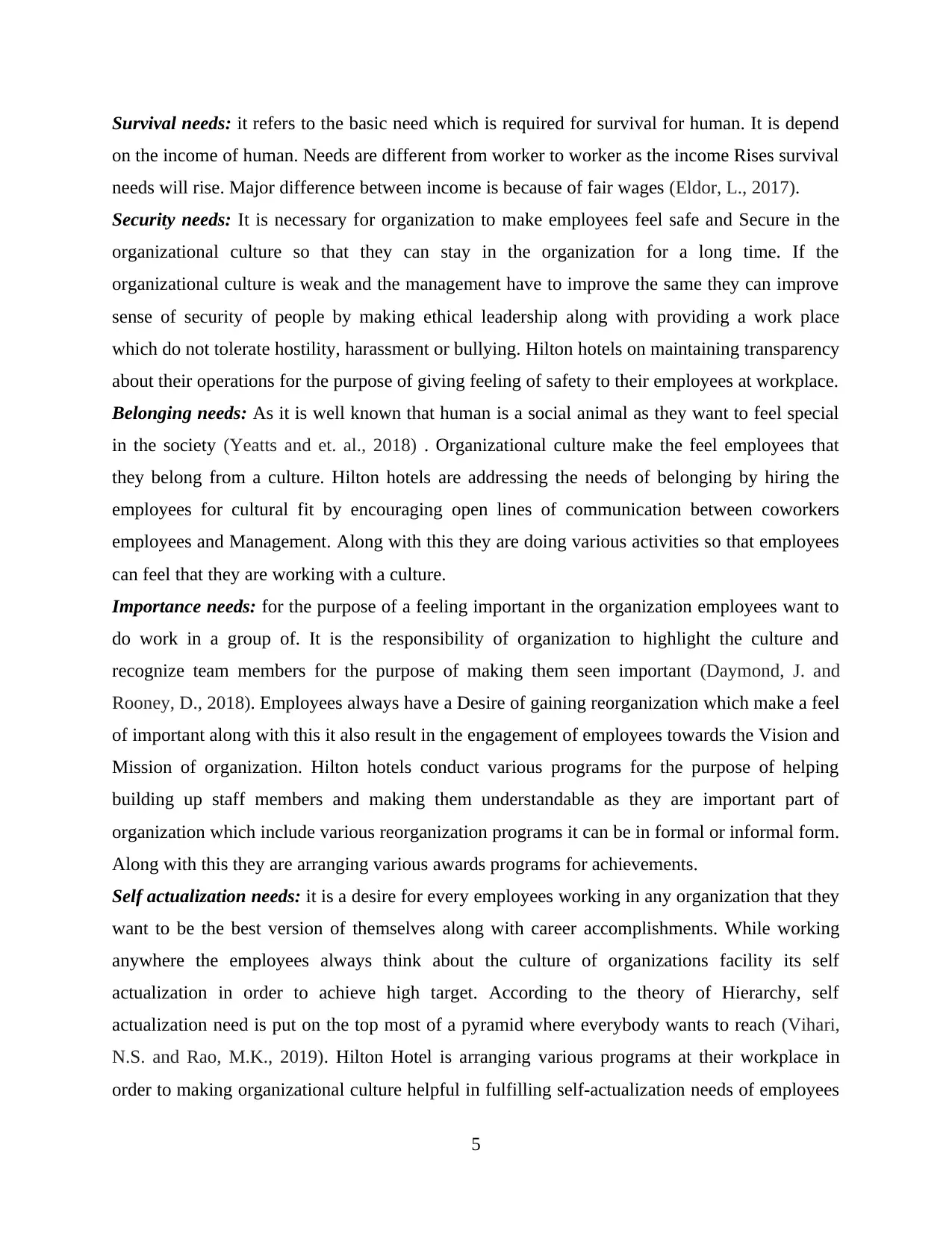
Survival needs: it refers to the basic need which is required for survival for human. It is depend
on the income of human. Needs are different from worker to worker as the income Rises survival
needs will rise. Major difference between income is because of fair wages (Eldor, L., 2017).
Security needs: It is necessary for organization to make employees feel safe and Secure in the
organizational culture so that they can stay in the organization for a long time. If the
organizational culture is weak and the management have to improve the same they can improve
sense of security of people by making ethical leadership along with providing a work place
which do not tolerate hostility, harassment or bullying. Hilton hotels on maintaining transparency
about their operations for the purpose of giving feeling of safety to their employees at workplace.
Belonging needs: As it is well known that human is a social animal as they want to feel special
in the society (Yeatts and et. al., 2018) . Organizational culture make the feel employees that
they belong from a culture. Hilton hotels are addressing the needs of belonging by hiring the
employees for cultural fit by encouraging open lines of communication between coworkers
employees and Management. Along with this they are doing various activities so that employees
can feel that they are working with a culture.
Importance needs: for the purpose of a feeling important in the organization employees want to
do work in a group of. It is the responsibility of organization to highlight the culture and
recognize team members for the purpose of making them seen important (Daymond, J. and
Rooney, D., 2018). Employees always have a Desire of gaining reorganization which make a feel
of important along with this it also result in the engagement of employees towards the Vision and
Mission of organization. Hilton hotels conduct various programs for the purpose of helping
building up staff members and making them understandable as they are important part of
organization which include various reorganization programs it can be in formal or informal form.
Along with this they are arranging various awards programs for achievements.
Self actualization needs: it is a desire for every employees working in any organization that they
want to be the best version of themselves along with career accomplishments. While working
anywhere the employees always think about the culture of organizations facility its self
actualization in order to achieve high target. According to the theory of Hierarchy, self
actualization need is put on the top most of a pyramid where everybody wants to reach (Vihari,
N.S. and Rao, M.K., 2019). Hilton Hotel is arranging various programs at their workplace in
order to making organizational culture helpful in fulfilling self-actualization needs of employees
5
on the income of human. Needs are different from worker to worker as the income Rises survival
needs will rise. Major difference between income is because of fair wages (Eldor, L., 2017).
Security needs: It is necessary for organization to make employees feel safe and Secure in the
organizational culture so that they can stay in the organization for a long time. If the
organizational culture is weak and the management have to improve the same they can improve
sense of security of people by making ethical leadership along with providing a work place
which do not tolerate hostility, harassment or bullying. Hilton hotels on maintaining transparency
about their operations for the purpose of giving feeling of safety to their employees at workplace.
Belonging needs: As it is well known that human is a social animal as they want to feel special
in the society (Yeatts and et. al., 2018) . Organizational culture make the feel employees that
they belong from a culture. Hilton hotels are addressing the needs of belonging by hiring the
employees for cultural fit by encouraging open lines of communication between coworkers
employees and Management. Along with this they are doing various activities so that employees
can feel that they are working with a culture.
Importance needs: for the purpose of a feeling important in the organization employees want to
do work in a group of. It is the responsibility of organization to highlight the culture and
recognize team members for the purpose of making them seen important (Daymond, J. and
Rooney, D., 2018). Employees always have a Desire of gaining reorganization which make a feel
of important along with this it also result in the engagement of employees towards the Vision and
Mission of organization. Hilton hotels conduct various programs for the purpose of helping
building up staff members and making them understandable as they are important part of
organization which include various reorganization programs it can be in formal or informal form.
Along with this they are arranging various awards programs for achievements.
Self actualization needs: it is a desire for every employees working in any organization that they
want to be the best version of themselves along with career accomplishments. While working
anywhere the employees always think about the culture of organizations facility its self
actualization in order to achieve high target. According to the theory of Hierarchy, self
actualization need is put on the top most of a pyramid where everybody wants to reach (Vihari,
N.S. and Rao, M.K., 2019). Hilton Hotel is arranging various programs at their workplace in
order to making organizational culture helpful in fulfilling self-actualization needs of employees
5
Paraphrase This Document
Need a fresh take? Get an instant paraphrase of this document with our AI Paraphraser
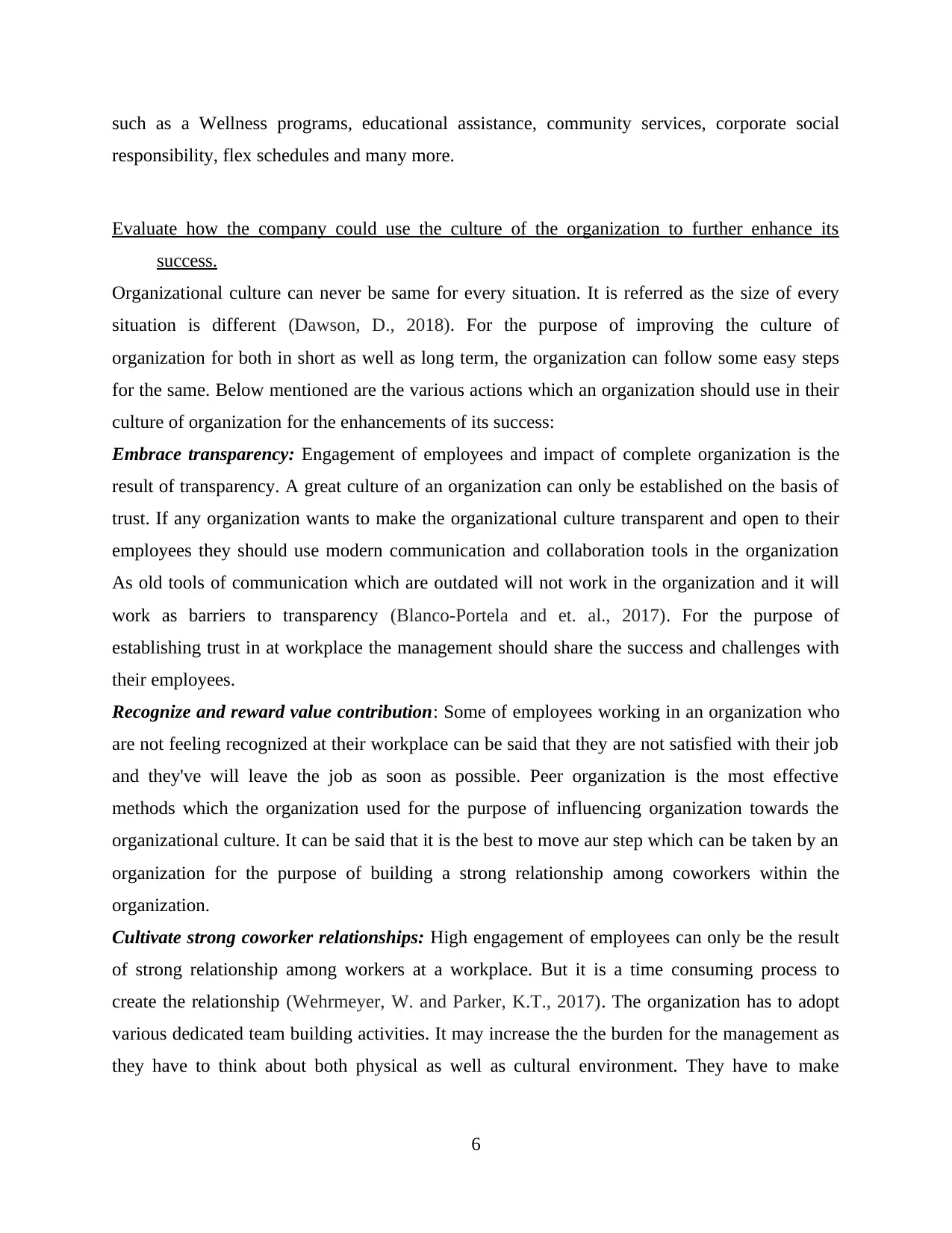
such as a Wellness programs, educational assistance, community services, corporate social
responsibility, flex schedules and many more.
Evaluate how the company could use the culture of the organization to further enhance its
success.
Organizational culture can never be same for every situation. It is referred as the size of every
situation is different (Dawson, D., 2018). For the purpose of improving the culture of
organization for both in short as well as long term, the organization can follow some easy steps
for the same. Below mentioned are the various actions which an organization should use in their
culture of organization for the enhancements of its success:
Embrace transparency: Engagement of employees and impact of complete organization is the
result of transparency. A great culture of an organization can only be established on the basis of
trust. If any organization wants to make the organizational culture transparent and open to their
employees they should use modern communication and collaboration tools in the organization
As old tools of communication which are outdated will not work in the organization and it will
work as barriers to transparency (Blanco-Portela and et. al., 2017). For the purpose of
establishing trust in at workplace the management should share the success and challenges with
their employees.
Recognize and reward value contribution: Some of employees working in an organization who
are not feeling recognized at their workplace can be said that they are not satisfied with their job
and they've will leave the job as soon as possible. Peer organization is the most effective
methods which the organization used for the purpose of influencing organization towards the
organizational culture. It can be said that it is the best to move aur step which can be taken by an
organization for the purpose of building a strong relationship among coworkers within the
organization.
Cultivate strong coworker relationships: High engagement of employees can only be the result
of strong relationship among workers at a workplace. But it is a time consuming process to
create the relationship (Wehrmeyer, W. and Parker, K.T., 2017). The organization has to adopt
various dedicated team building activities. It may increase the the burden for the management as
they have to think about both physical as well as cultural environment. They have to make
6
responsibility, flex schedules and many more.
Evaluate how the company could use the culture of the organization to further enhance its
success.
Organizational culture can never be same for every situation. It is referred as the size of every
situation is different (Dawson, D., 2018). For the purpose of improving the culture of
organization for both in short as well as long term, the organization can follow some easy steps
for the same. Below mentioned are the various actions which an organization should use in their
culture of organization for the enhancements of its success:
Embrace transparency: Engagement of employees and impact of complete organization is the
result of transparency. A great culture of an organization can only be established on the basis of
trust. If any organization wants to make the organizational culture transparent and open to their
employees they should use modern communication and collaboration tools in the organization
As old tools of communication which are outdated will not work in the organization and it will
work as barriers to transparency (Blanco-Portela and et. al., 2017). For the purpose of
establishing trust in at workplace the management should share the success and challenges with
their employees.
Recognize and reward value contribution: Some of employees working in an organization who
are not feeling recognized at their workplace can be said that they are not satisfied with their job
and they've will leave the job as soon as possible. Peer organization is the most effective
methods which the organization used for the purpose of influencing organization towards the
organizational culture. It can be said that it is the best to move aur step which can be taken by an
organization for the purpose of building a strong relationship among coworkers within the
organization.
Cultivate strong coworker relationships: High engagement of employees can only be the result
of strong relationship among workers at a workplace. But it is a time consuming process to
create the relationship (Wehrmeyer, W. and Parker, K.T., 2017). The organization has to adopt
various dedicated team building activities. It may increase the the burden for the management as
they have to think about both physical as well as cultural environment. They have to make
6
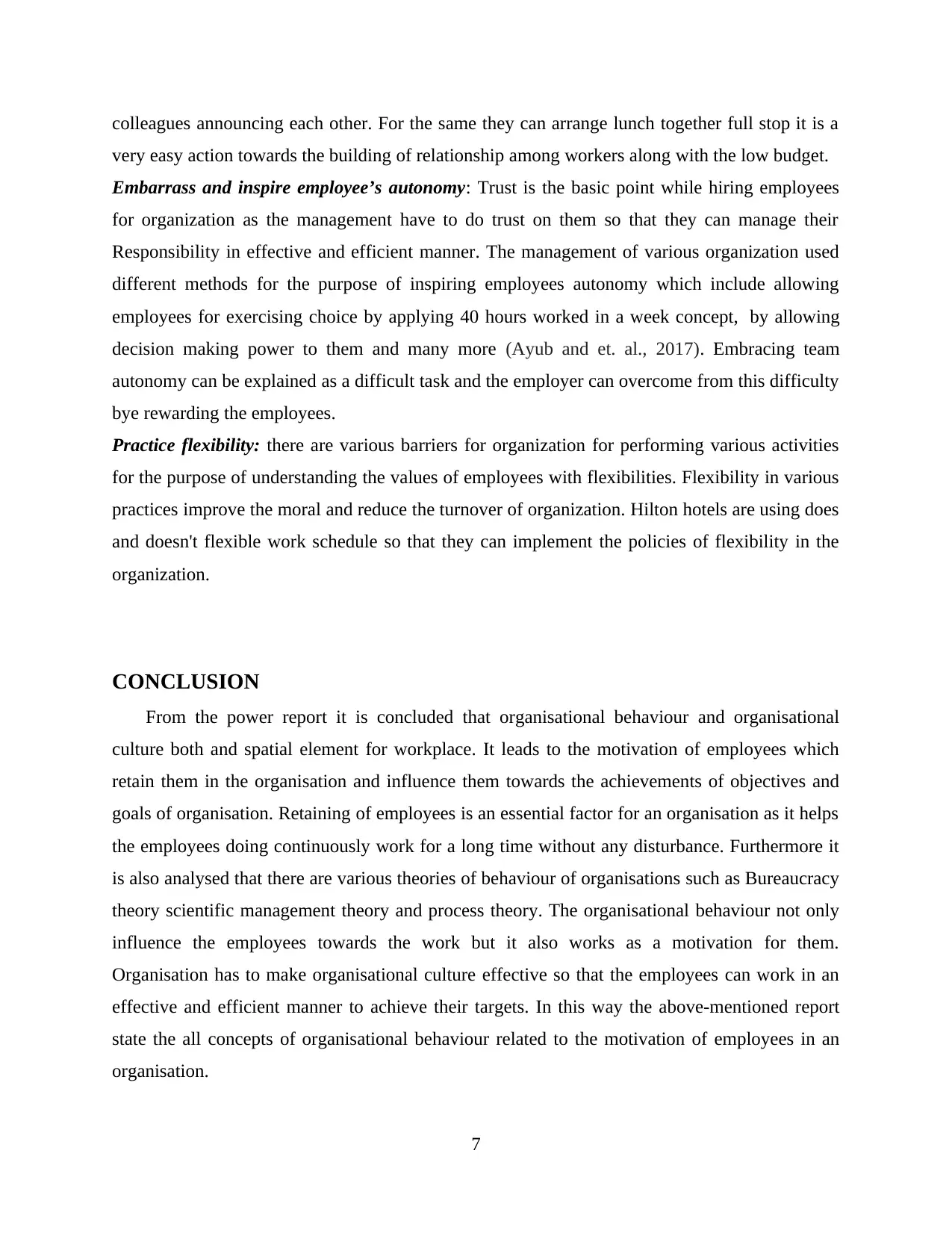
colleagues announcing each other. For the same they can arrange lunch together full stop it is a
very easy action towards the building of relationship among workers along with the low budget.
Embarrass and inspire employee’s autonomy: Trust is the basic point while hiring employees
for organization as the management have to do trust on them so that they can manage their
Responsibility in effective and efficient manner. The management of various organization used
different methods for the purpose of inspiring employees autonomy which include allowing
employees for exercising choice by applying 40 hours worked in a week concept, by allowing
decision making power to them and many more (Ayub and et. al., 2017). Embracing team
autonomy can be explained as a difficult task and the employer can overcome from this difficulty
bye rewarding the employees.
Practice flexibility: there are various barriers for organization for performing various activities
for the purpose of understanding the values of employees with flexibilities. Flexibility in various
practices improve the moral and reduce the turnover of organization. Hilton hotels are using does
and doesn't flexible work schedule so that they can implement the policies of flexibility in the
organization.
CONCLUSION
From the power report it is concluded that organisational behaviour and organisational
culture both and spatial element for workplace. It leads to the motivation of employees which
retain them in the organisation and influence them towards the achievements of objectives and
goals of organisation. Retaining of employees is an essential factor for an organisation as it helps
the employees doing continuously work for a long time without any disturbance. Furthermore it
is also analysed that there are various theories of behaviour of organisations such as Bureaucracy
theory scientific management theory and process theory. The organisational behaviour not only
influence the employees towards the work but it also works as a motivation for them.
Organisation has to make organisational culture effective so that the employees can work in an
effective and efficient manner to achieve their targets. In this way the above-mentioned report
state the all concepts of organisational behaviour related to the motivation of employees in an
organisation.
7
very easy action towards the building of relationship among workers along with the low budget.
Embarrass and inspire employee’s autonomy: Trust is the basic point while hiring employees
for organization as the management have to do trust on them so that they can manage their
Responsibility in effective and efficient manner. The management of various organization used
different methods for the purpose of inspiring employees autonomy which include allowing
employees for exercising choice by applying 40 hours worked in a week concept, by allowing
decision making power to them and many more (Ayub and et. al., 2017). Embracing team
autonomy can be explained as a difficult task and the employer can overcome from this difficulty
bye rewarding the employees.
Practice flexibility: there are various barriers for organization for performing various activities
for the purpose of understanding the values of employees with flexibilities. Flexibility in various
practices improve the moral and reduce the turnover of organization. Hilton hotels are using does
and doesn't flexible work schedule so that they can implement the policies of flexibility in the
organization.
CONCLUSION
From the power report it is concluded that organisational behaviour and organisational
culture both and spatial element for workplace. It leads to the motivation of employees which
retain them in the organisation and influence them towards the achievements of objectives and
goals of organisation. Retaining of employees is an essential factor for an organisation as it helps
the employees doing continuously work for a long time without any disturbance. Furthermore it
is also analysed that there are various theories of behaviour of organisations such as Bureaucracy
theory scientific management theory and process theory. The organisational behaviour not only
influence the employees towards the work but it also works as a motivation for them.
Organisation has to make organisational culture effective so that the employees can work in an
effective and efficient manner to achieve their targets. In this way the above-mentioned report
state the all concepts of organisational behaviour related to the motivation of employees in an
organisation.
7
⊘ This is a preview!⊘
Do you want full access?
Subscribe today to unlock all pages.

Trusted by 1+ million students worldwide
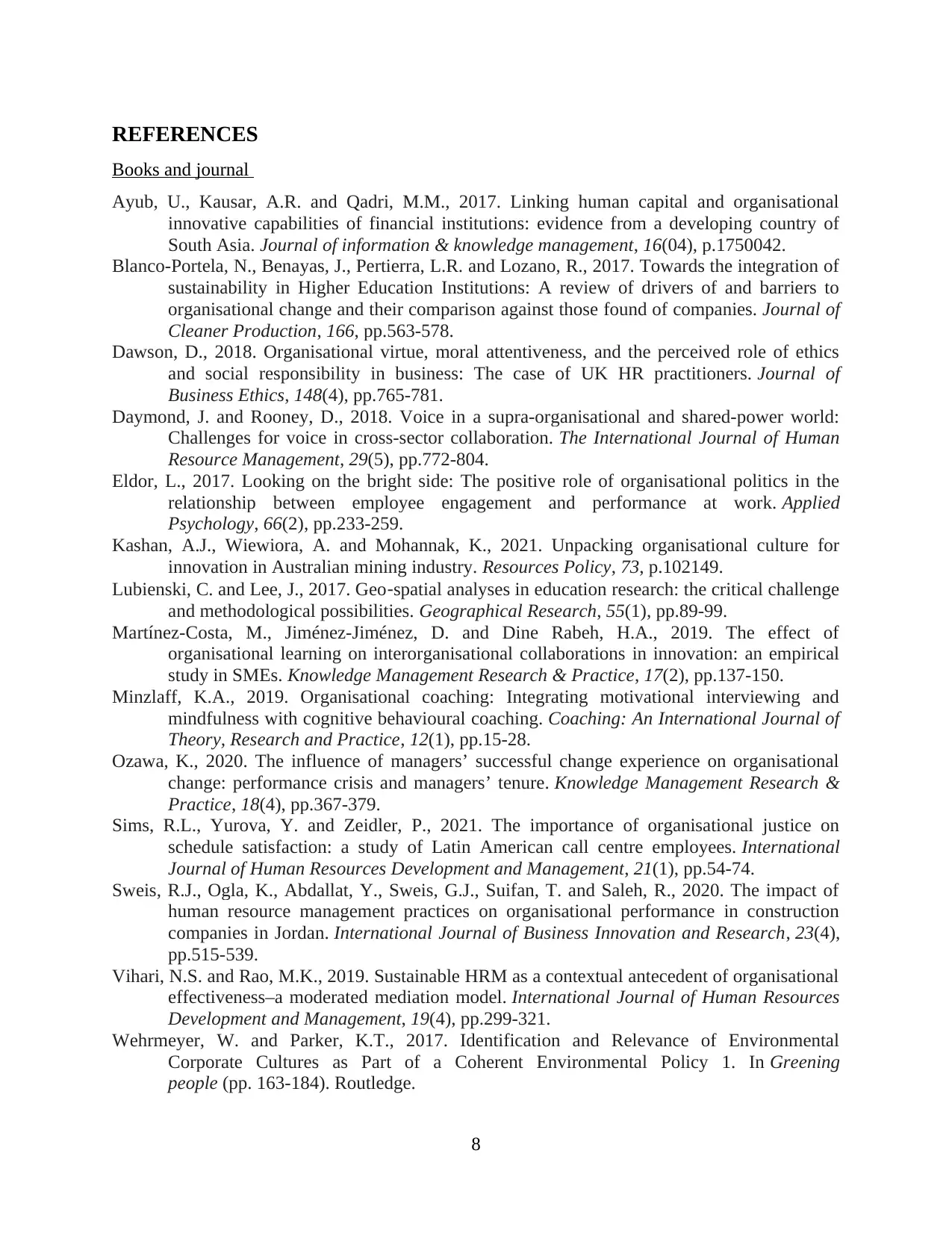
REFERENCES
Books and journal
Ayub, U., Kausar, A.R. and Qadri, M.M., 2017. Linking human capital and organisational
innovative capabilities of financial institutions: evidence from a developing country of
South Asia. Journal of information & knowledge management, 16(04), p.1750042.
Blanco-Portela, N., Benayas, J., Pertierra, L.R. and Lozano, R., 2017. Towards the integration of
sustainability in Higher Education Institutions: A review of drivers of and barriers to
organisational change and their comparison against those found of companies. Journal of
Cleaner Production, 166, pp.563-578.
Dawson, D., 2018. Organisational virtue, moral attentiveness, and the perceived role of ethics
and social responsibility in business: The case of UK HR practitioners. Journal of
Business Ethics, 148(4), pp.765-781.
Daymond, J. and Rooney, D., 2018. Voice in a supra-organisational and shared-power world:
Challenges for voice in cross-sector collaboration. The International Journal of Human
Resource Management, 29(5), pp.772-804.
Eldor, L., 2017. Looking on the bright side: The positive role of organisational politics in the
relationship between employee engagement and performance at work. Applied
Psychology, 66(2), pp.233-259.
Kashan, A.J., Wiewiora, A. and Mohannak, K., 2021. Unpacking organisational culture for
innovation in Australian mining industry. Resources Policy, 73, p.102149.
Lubienski, C. and Lee, J., 2017. Geo‐spatial analyses in education research: the critical challenge
and methodological possibilities. Geographical Research, 55(1), pp.89-99.
Martínez-Costa, M., Jiménez-Jiménez, D. and Dine Rabeh, H.A., 2019. The effect of
organisational learning on interorganisational collaborations in innovation: an empirical
study in SMEs. Knowledge Management Research & Practice, 17(2), pp.137-150.
Minzlaff, K.A., 2019. Organisational coaching: Integrating motivational interviewing and
mindfulness with cognitive behavioural coaching. Coaching: An International Journal of
Theory, Research and Practice, 12(1), pp.15-28.
Ozawa, K., 2020. The influence of managers’ successful change experience on organisational
change: performance crisis and managers’ tenure. Knowledge Management Research &
Practice, 18(4), pp.367-379.
Sims, R.L., Yurova, Y. and Zeidler, P., 2021. The importance of organisational justice on
schedule satisfaction: a study of Latin American call centre employees. International
Journal of Human Resources Development and Management, 21(1), pp.54-74.
Sweis, R.J., Ogla, K., Abdallat, Y., Sweis, G.J., Suifan, T. and Saleh, R., 2020. The impact of
human resource management practices on organisational performance in construction
companies in Jordan. International Journal of Business Innovation and Research, 23(4),
pp.515-539.
Vihari, N.S. and Rao, M.K., 2019. Sustainable HRM as a contextual antecedent of organisational
effectiveness–a moderated mediation model. International Journal of Human Resources
Development and Management, 19(4), pp.299-321.
Wehrmeyer, W. and Parker, K.T., 2017. Identification and Relevance of Environmental
Corporate Cultures as Part of a Coherent Environmental Policy 1. In Greening
people (pp. 163-184). Routledge.
8
Books and journal
Ayub, U., Kausar, A.R. and Qadri, M.M., 2017. Linking human capital and organisational
innovative capabilities of financial institutions: evidence from a developing country of
South Asia. Journal of information & knowledge management, 16(04), p.1750042.
Blanco-Portela, N., Benayas, J., Pertierra, L.R. and Lozano, R., 2017. Towards the integration of
sustainability in Higher Education Institutions: A review of drivers of and barriers to
organisational change and their comparison against those found of companies. Journal of
Cleaner Production, 166, pp.563-578.
Dawson, D., 2018. Organisational virtue, moral attentiveness, and the perceived role of ethics
and social responsibility in business: The case of UK HR practitioners. Journal of
Business Ethics, 148(4), pp.765-781.
Daymond, J. and Rooney, D., 2018. Voice in a supra-organisational and shared-power world:
Challenges for voice in cross-sector collaboration. The International Journal of Human
Resource Management, 29(5), pp.772-804.
Eldor, L., 2017. Looking on the bright side: The positive role of organisational politics in the
relationship between employee engagement and performance at work. Applied
Psychology, 66(2), pp.233-259.
Kashan, A.J., Wiewiora, A. and Mohannak, K., 2021. Unpacking organisational culture for
innovation in Australian mining industry. Resources Policy, 73, p.102149.
Lubienski, C. and Lee, J., 2017. Geo‐spatial analyses in education research: the critical challenge
and methodological possibilities. Geographical Research, 55(1), pp.89-99.
Martínez-Costa, M., Jiménez-Jiménez, D. and Dine Rabeh, H.A., 2019. The effect of
organisational learning on interorganisational collaborations in innovation: an empirical
study in SMEs. Knowledge Management Research & Practice, 17(2), pp.137-150.
Minzlaff, K.A., 2019. Organisational coaching: Integrating motivational interviewing and
mindfulness with cognitive behavioural coaching. Coaching: An International Journal of
Theory, Research and Practice, 12(1), pp.15-28.
Ozawa, K., 2020. The influence of managers’ successful change experience on organisational
change: performance crisis and managers’ tenure. Knowledge Management Research &
Practice, 18(4), pp.367-379.
Sims, R.L., Yurova, Y. and Zeidler, P., 2021. The importance of organisational justice on
schedule satisfaction: a study of Latin American call centre employees. International
Journal of Human Resources Development and Management, 21(1), pp.54-74.
Sweis, R.J., Ogla, K., Abdallat, Y., Sweis, G.J., Suifan, T. and Saleh, R., 2020. The impact of
human resource management practices on organisational performance in construction
companies in Jordan. International Journal of Business Innovation and Research, 23(4),
pp.515-539.
Vihari, N.S. and Rao, M.K., 2019. Sustainable HRM as a contextual antecedent of organisational
effectiveness–a moderated mediation model. International Journal of Human Resources
Development and Management, 19(4), pp.299-321.
Wehrmeyer, W. and Parker, K.T., 2017. Identification and Relevance of Environmental
Corporate Cultures as Part of a Coherent Environmental Policy 1. In Greening
people (pp. 163-184). Routledge.
8
Paraphrase This Document
Need a fresh take? Get an instant paraphrase of this document with our AI Paraphraser
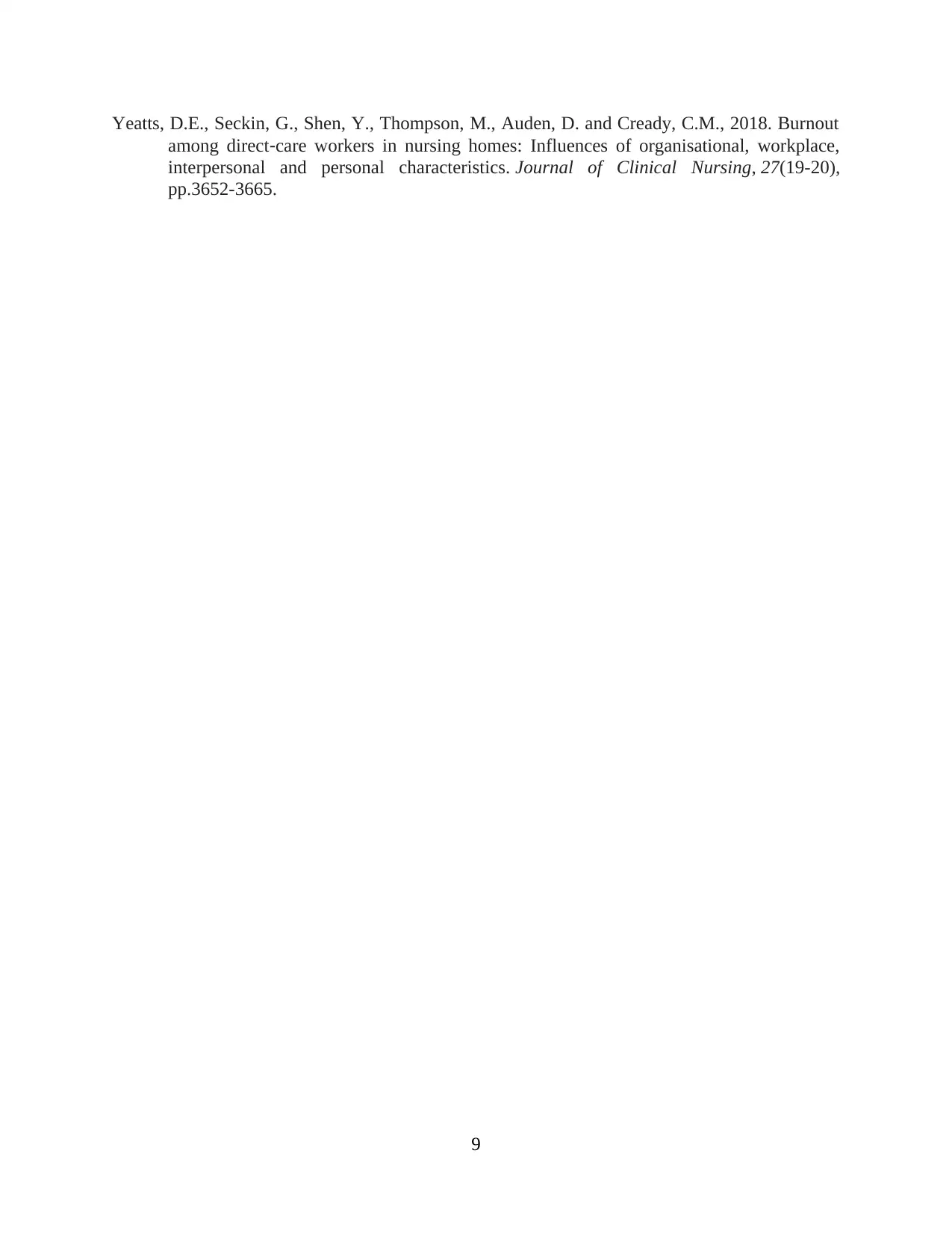
Yeatts, D.E., Seckin, G., Shen, Y., Thompson, M., Auden, D. and Cready, C.M., 2018. Burnout
among direct‐care workers in nursing homes: Influences of organisational, workplace,
interpersonal and personal characteristics. Journal of Clinical Nursing, 27(19-20),
pp.3652-3665.
9
among direct‐care workers in nursing homes: Influences of organisational, workplace,
interpersonal and personal characteristics. Journal of Clinical Nursing, 27(19-20),
pp.3652-3665.
9
1 out of 11
Related Documents
Your All-in-One AI-Powered Toolkit for Academic Success.
+13062052269
info@desklib.com
Available 24*7 on WhatsApp / Email
![[object Object]](/_next/static/media/star-bottom.7253800d.svg)
Unlock your academic potential
Copyright © 2020–2025 A2Z Services. All Rights Reserved. Developed and managed by ZUCOL.





